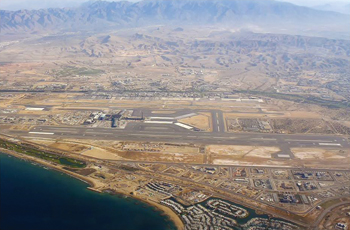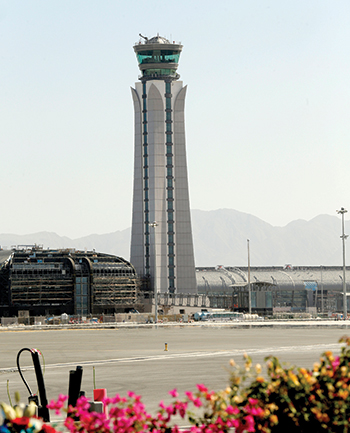
 Phase One of Muscat International Airport expansion ... to handle 12 million visitors annually.
Phase One of Muscat International Airport expansion ... to handle 12 million visitors annually.
AFTER a series of delays, Oman’s showpiece civil construction project – the expansion and modernisation of Muscat International Airport – is now well and truly on the road to completion.
A firm launch date is, however, still up in the air, with authorities reluctant to go on record with the revised schedule, having seen a series of missed deadlines.
At an estimated $5.2 billion in project costs, the new airport development is billed as the single biggest civil construction undertaking in Oman’s modern history. It includes the construction of a state-of-the-art passenger terminal, a 100-m-tall air traffic control tower, two runways, more than 7,000 parking spaces, a civil aviation headquarters and an air cargo terminal.
Phase One, which will see capacity boosted to 12 million passengers a year, is in an advanced stage of completion. Further expansions planned in three subsequent phases will ultimately boost the airport’s capacity to 24, 36 and 48 million passengers when demand is required. This represents a quantum leap over the airport’s current capacity of 2 million passengers per year, which in reality handles 9 million passengers and 40 airlines.
Commenting on the completion date of the project, Saeed Khamis Al Zadjali, acting CEO, Oman Airports Management Company (OAMC), told the Oman Observer: “It is always difficult to predict whether contractors and engineers can deliver on a promised date. We can never be 100 per cent certain because some unforeseen events can slow down the pace of construction. Even otherwise, we can expect some teething problems and have to be convinced that the project is designed as per the tender.”
 |
Nevertheless, the Public Authority for Civil Aviation (Paca), which is overseeing the execution of the multi-billion-dollar project, has its sights on an end-2016/early-2017 timeframe to bring the ambitious scheme into operation. A succession of high-profile visits by Paca officials, accompanied by Dr Ahmed bin Mohammed Al Futaisi, Oman’s Minister of Transport and Communications, has served to signal the government’s displeasure over the delays, and its intent to see the project through to fruition expeditiously.
From the outset, the airport redevelopment project has been beset by delays attributable to design variations, approvals, supply chain impediments, labour strife and even the exit of its high-profile design consultant Cowi Larsen.
These setbacks, officials argue, are no different from problems faced by similar large-scale projects undertaken anywhere else around the world.
“Some of these factors are genuine and from my years of experience in the engineering field, I can say that in cases of big-ticket projects, it is difficult to deliver on time as promised. As the airport project is divided into different packages, even a small delay in one package can affect the other,” Al Zadjali added.
However, several key components of this grand scheme have already been commissioned and brought into operation, buoying hopes for its early overall completion. Last December, authorities celebrated the successful landing of the new airport’s maiden commercial flight on a newly built runway. Operated by national carrier Oman Air, the Airbus A330 touched down on the North Runway, a 4-km-long airstrip designed to accommodate even the largest commercial aircraft in operation today. In attendance was a contingent of high-ranking officials, their presence attesting to the importance accorded by the government to the speedy completion of the project.
More recently, Spanish technology giant Indra formally declared the airport’s air traffic control (ATC) tower to be fully operational. The Madrid-headquartered multinational says its new-generation technology and systems now makes it possible for air traffic controllers to handle a flight every two minutes, thus tripling the airport’s previous capacity and readying it to receive the new A380, the world’s largest commercial aircraft.
 |
The ATC tower at the Muscat International Airport... fully operational. |
Under a contract awarded by the Omani government in 2010, Indra deployed ground-to-air voice communication systems, a meteorological system to improve forecasting capabilities at the Directorate General of Meteorology and Air Navigation, as well as the deployment of two surface movement guidance and control systems at the Muscat and Salalah gateways.
Given the complex nature of the airport redevelopment project, Paca has broken it up into 13 discrete packages, each worth several hundred million dollars. In advanced stages of execution are the Paca headquarters, the new air traffic management complex; data centre; contingency and trading building; and crash, fire and rescue facility. Complementing these facilities is a new air cargo terminal with a capacity of 100,000 tonnes per year, as well as a modern in-flight catering facility.
The principal consultant on the project is Hill International, while the contractors handling various packages include: Bechtel Enka Bahwan (BEB) joint venture; Consolidated Contractors Company-TAV joint venture; and Carillion Alawi, among others.
The imposing shell of the centrepiece passenger terminal itself is largely in place, with an army of contractors busy at work fitting out the interiors, and installing the IT and security systems. Also being rolled out is a sophisticated baggage handling system capable of processing a staggering 5,500 per hour. Passenger boarding bridges – numbering 40 in all – are being readied for deployment as well.
Fuelling the urgency to bring the mammoth project into operation is the strong uptrend in passenger traffic that has left the existing airport facility virtually bursting at the seams. By end-2014, passenger throughput surged to a staggering nine million, representing a nearly five-fold increase over the facility’s design capacity of two million visitors per year, according to the Oman Airports Management Company (OAMC). Passenger numbers were up six per cent from the previous year’s tally of around 8.5 million travellers.
Around 40 airlines currently call at Muscat International Airport, with new carriers eager to sign up for landing rights when the expanded gateway is operational. Furthermore, with some 1,200 airplanes overflying Omani airspace on a daily basis, the government is keen to position Muscat as an international air transit hub – a move designed to drive tourist inflows.





















_0001.jpg)


.jpg)
















.jpg)








.jpg)




